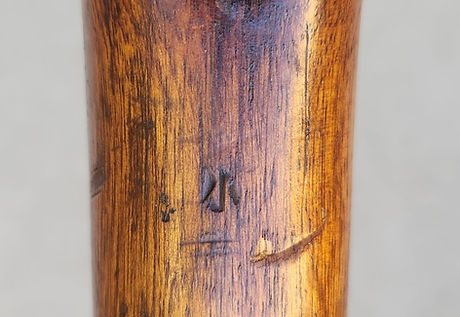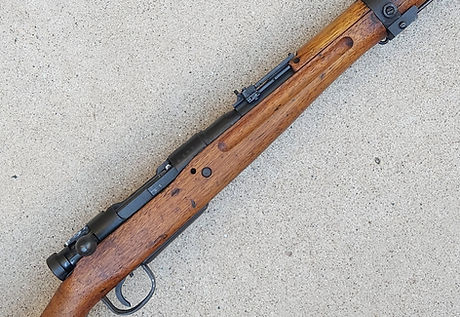
TYPE 99 SHORT RIFLE
ARISAKA
Japan
BRIEF OVERALL HISTORY
The Japanese Type 99 rifle was adopted in 1939 and replaced their Type 38 rifle. Japan had decided the 6.5mm cartridge of the Type 38 rifle needed to be replace by something similar to the 7.7mm cartridge fired in their Light Machine Gun. The Type 99 was based on the Type 38 rifle but chambered in the 7.7x58mm cartridge. Its replacement of the Type 38 rifle was not fully realized before the end of WWII. As WWII progressed, the Type 99 was repeatedly simplified for speed of manufacturing and availability of recourses. This is an early model and has many features later removed.

MODEL
The model is marked on top of the receiver in Japanese. It is written as "99 Type" with the last character being "Shiki" or type. The Type 99 rifle was adopted in Japanese calendar year 2599 (Western calendar year 1939), thus the 99 designation.

CHRYSANTHEMUM ("MUM")
Above the model was a sixteen petal chrysanthemum, commonly referred to as a "Mum" (Insert). This was the symbol of the Japanese Emperor. It indicated the weapon was made for the Japanese Army and was the property of the Emperor. After Japan's surrender at the end of WWII, the chrysanthemums were typically removed or defaced on surrendered weapons by grinding or filing, which can be seen on this rifle.

SERIES AND SERIAL NUMBER
On the left side of the receiver are a series of marks, starting with the "series". The series is a block of 99,999 serial numbers. The series is denoted by a Japanese character with in a circle. These characters are called Kana. This is a series 22 mark, which was the 3rd series assigned to Kokura Arsenal. Following the series mark is the serial number.

ARSENAL MARK (MANUFACTURER)
At the end of the serial number is the arsenal mark. This mark was used by the Kokura Arsenal located in Kokura, Japan. The mark represents a stack of four cannon balls viewed from above.

FINAL INSPECTION/ ACCEPTANCE MARK
The marks to the right of the arsenal mark are possibly final inspection and/or acceptance marks of the rifle.

Inspection Marks
As parts were completed they would be inspected. After being inspected they were marked. This mark is the Kana character セ, representing the sound "se" and was used by Kokura Arsenal.




ADDITIONAL SERIAL NUMBERS
After serialization, some parts were marked with the last three digits of the serial number. This would aid in assembly of the rifle with the correct parts during batch processing, cleaning, or repair.




DUST COVER
The cuts along the receiver on the left side, above the serial number, and the right sight, just above the stock line, are guides for a receiver dust cover. These were often lost or removed during the rifles service life or just not included in later models.

GAS VENT HOLE
The hole on top of the receiver is a gas vent hole. In the event of a ruptured case, this gives gas from the burning powder a place to vent out of the receiver, lowing chamber pressure, to prevent failure of the bolt locking lugs.

SAFETY KNOB
The rear of the safety knob is knurled providing some grip when engaging/disengaging the safety. As the machining to do this is fairly involved, this was simplified and completely done away with a production of the rifle was streamlined as WWII progressed.

REAR SIGHT
The rear sight includes both a battle sight and a sight ladder. The ladder is graduated to 1500 m and includes anti-aircraft lead wings that fold down from the slider.

FRONT SIGHT
The front sight is a barleycorn blade dovetailed in to the front sight base. Early production rifles had the protective ears seen here but these were later eliminated to simplify manufacturing.

CHROM LINED BARREL
The bores of Type 99 rifles were initially chrome lined. This prevented corrosion due to the use of corrosive ammo and the tropical environment the rifles were often used in. This was stopped mid way through WWII for cost and time savings. The chrome lining can be seen with the bright ring on the inside of the muzzle.

STOCK
The stock is made from two pieces of wood. This created less waist, and also allowed the tow of the rifle to be stronger with the wood grain in line of the bottom edge of the stock.

CLEANING ROD
A cleaning rod section is stored below the barrel in the forend of the stock. It is 23.75 inches long and is threaded on one end with a slotted patch tip on the other. It is retained by a small catch on the bottom of the forend, which is released by depressing the small square catch. The cleaning rod section would be used in conjunction with a cleaning kit that included additional cleaning rod sections. While in the rifle forend, the cleaning rod was additionally used as a stacking rod.
.jpg)
WATER DRAIN HOLES
In the stock are two drilled holes. One forward of the trigger guard and the other on the right side, below the chamber. These are water drain holes to allow water to exit the stock if the rifle becomes submerged.

MONOPOD
The Type 99 was initially produced with a monopod attached to the rear band. It was 11 inches long and folded under the forend of the stock, with the foot wrapping around the front band.

STAKED SCREWS
The guard screws on Type 99 rifles were often staked from the factory. This was to ensure the screws did not come loose and was done by using a punch to displace some of the metal from the trigger guard against the guard screw.

Chief Inspector Marking
This is the Department of Control, or chief inspector, marking from the Kokura Arsenal.

IMPORT
At some point this rifle was imported in to the U.S. Of note is the lack of an import mark. Import marks were not required until 1986. With the ground mum as noted earlier, it was most likely imported sometime between the end of WWII and 1986.

HISTORICAL PHOTOGRAPHS




Videos








RESOURCES
by Jr. Honeycutt, Fred L., F. Patt Anthony
By Duncan O. McCollum
By Ian D. Skennerton
type99arisakas.weebly.com
holdmilitarymarkings.com/japanese_markings.html



